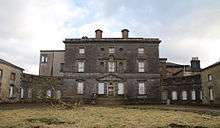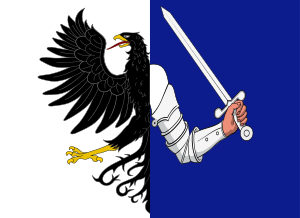Hazelwood House, Sligo
Hazelwood House is an 18th-century Palladian style country house located in a 70-acre (28 ha) demesne in the parish of Calry, some 2 miles (3 km) south-east of the town of Sligo in north-west Ireland. It has been described as one of County Sligo's most neglected treasures. In addition to its architectural value, the house is important both socially and historically.[1]

Location
Situated on a peninsula jutting into Lough Gill east of Sligo town with views of Ben Bulben to the north, the house stands in a wooded estate originally 15,000 acres (6,100 ha) in extent, but now reduced to 81 acres (33 ha).
Architecture

The house was the first Palladian house in Ireland designed by Richard Cassels (c.1730), the architect who also designed Leinster House, Powerscourt House and Russborough House.
It consists of a 5-bay by 3-bay main block in three storeys with 2-storey wings on either side connected to the main block by single-storey quadrants. The building is constructed of limestone ashlar with slate roofs.[1]
Since construction, the house saw several decades of neglect and alteration. For example, in the 1870s, a three-bay, two-storey wing was added on the western side of the main block. The main staircase was removed in the 1950s and replaced with a concrete flight of stairs. A number of chimney pieces were taken and replaced with replicas.[2]
History
The original name for the area is Annagh (Eanach) meaning "marsh" and was on land belonging to the Ó Conchobhair Sligigh Lords of the territory of Cairbre Drom Cliabh.
There was an O'Conor castle located here that according to O'Rorke (1889) was at Castle Point on Lough Gill south of the present house.
This area belonged to the O'Connor's throughout the Medieval period before passing to the merchant Andrew Crean in the early 17th century, then to Lord William Strafford.
In 1635, during the planning for the aborted Plantation of Connacht, the estate was bought by Sir Phillip Perceval acting secretly on behalf of the Lord Deputy Wentworth and Sir George Radcliffe. Subsequent allegations claimed that Perceval tricked O'Connor into selling by claiming that it belonged to the Crown and would be subject to Plantation without any recompense to O'Connor. The hostility created by this was instrumental in the Sligo gentries taking part in the 1641 rebellion.
In 1687 it went to Thomas Wilson and in 1722 to the Wynnes.
The Wynne Family
Lt-Gen. Owen Wynne, a descendant of the Welsh Wynne family from Merioneth purchased the estate in 1722. In addition to the 14,500 acres (5,900 ha) the conveyance also included extensive property within the Borough of Sligo, together with the fairs, markets and tolls.
On his death in 1737, the estate passed to his nephew, also Owen Wynne (1686–1755) who was an Army officer. He was succeeded by his son, a third Owen, who was High Sheriff of Sligo for 1723 and 1745. The house then passed to the latter's son, a fourth Owen (died 1789), who was an M.P. for County Sligo in the Irish Parliament and an Irish Privy Councillor. His eldest son, a fifth Owen (1755–1841), inherited the house on his death and was also an M.P. for County Sligo in the Irish Parliament and High Sheriff. He was followed by his son, John Arthur Wynne (1801–1865), MP for Sligo Borough and High Sheriff for 1840, and John Arthur's son, a sixth Owen (1843–1910), High Sheriff for 1874.[3]
The sixth Owen Wynne was the last Wynne to occupy Hazelwood House and died without a male heir in 1910. His daughter Murial and her husband Philip Dudley Percival then occupied the house, selling off the livestock and machinery until they left Hazelwood in 1923.
Recent history

The house then stood empty until 1930, when a retired tea planter named Berridge lived there, carrying out repairs and renovations before the house and lands were sold to the Land Commission and the State Forestry Department in 1937.
In 1940 the house was occupied by the Irish Army's 12th Cyclist Squadron and served as their barracks until January 1945.[4]
In 1946 it was sold to the Department of Health for use as a psychiatric hospital.
In c.1969 it was sold again to the Italian manufacturing company SNIA S.p.A. to use as part of a nylon yarn factory complex which they built to the rear of the house. The factory closed in 1983 and was acquired in 1987 by the South Korean company Saehan Media, who produced video tapes on the site until 2005.[1]
The property was sold in April 2006 for €7-€10 million to a local consortium, Foresthaze Developments, who applied in 2007 for permission to develop the site. The application was refused by Sligo County Council and the owners served with a notice to improve the fabric of the building to ensure its preservation.[3]
Empty since 1987, the house itself is now boarded up and in poor condition. Some members of the community want Hazelwood House and its grounds restored and developed as a tourism amenity.[5]
Foresthaze Developments was placed in receivership in October 2013.[2]
In 2015, the estate was purchased by David Raethorne, with plans for a whiskey distillery and visitors' centre on the site.[6] The Lough Gill Whiskey Distillery opened in December 2019.[7]
See also
References
| Wikimedia Commons has media related to Hazelwood House, Sligo. |
- "Hazelwood House, Sligo, County Sligo". National Inventory of Architectural Heritage. Retrieved 27 September 2013.
- Thompson, Sylvia (10 April 2014). "Buildings at Risk: Hazelwood House, Sligo". The Irish Times. Retrieved 8 May 2014.
- "Brief History of Hazelwood House". Archived from the original on 2 October 2013. Retrieved 27 September 2013.
- O'Reilly, Terence (4 October 2018). "Hazelwood House during the Emergency Years". The Irish Story. Retrieved 5 October 2018.
- Keaney, Harry (26 July 2014). "Develop Hazelwood House into top tourist destination". The Sligo Champion. Retrieved 2 August 2014 – via Irish Independent.
- "Sligo mansion to be transformed into tourist destination". The Irish Times. 25 January 2015. Retrieved 21 June 2020.
- "Whiskey rush as distillery numbers hit 120-year high". Irish Independent. 5 January 2020. Retrieved 22 June 2020.
